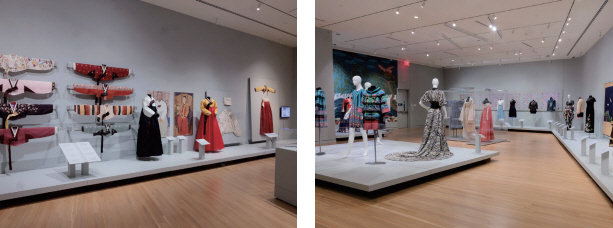In August 2022, The George Washington University Museum and The Textile Museum opened the exhibition Korean Fashion: From Royal Court to Runway. Including approximately ninety objects from museums and private collections in Korea and the USA, this is the first exhibition in the museum’s ninety-seven-year history to focus on Korea. Korean Fashion introduces American audiences to traditional Korean textile arts, from hanbok to home furnishings; explores how the design and craftsmanship of these textiles have changed alongside Korea’s socio-economic transformations since the late nineteenth century; and illustrates some of the ways that tradition continues to serve as a springboard for new expression among today’s designers and artists.
The exhibition begins with a group of textiles sent by the Joseon royal court to the World’s Columbian Exposition, held in Chicago in 1893. This was Korea’s first participation in a world’s fair, and at a time when the nation’s sovereignty was increasingly threatened, the fair offered the Joseon government the opportunity to positively introduce Korea, its people, and culture to a large global audience. The fine materials and workmanship of the garments, hats, and accessories chosen for display in the fair indicate production in the Joseon royal workshops. A finely quilted jacket (jeogori) and embroidered seating cushion (boryo) likely were made for King Gojong (1852~1919) himself. After the fair, these textiles went into the collection of the Field Museum in Chicago, and many are displayed for the first time since then in the Korean Fashion exhibition.
The next section of Korean Fashion explores changes in Korean clothing during the late nineteenth and early twentieth centuries, when the Joseon government issued a series of edicts intended to ref lect new political and cultural inf luences and to discourage conspicuous consumption. The exhibition illustrates the ascent of durumagi as the most common outer garment, the transition from gat to Western-style hats for men, and the introduction of new clothing forms from abroad, such as v and vests with pockets and buttons. In this and the previous section of the exhibition, digital slideshows of historical photographs and large-scale reproductions of portrait paintings provide visual context.

View of the exhibition Korean Fashion: From Royal Court to Runway Photo credit: William Atkins, George Washington University
Continuing into the post Korean War period, the exhibition showcases the fashions of pioneering Korean designers including Nora Noh (b. 1928), Andre Kim (1935~2010), and Icinoo (b. 1941). As the majority of Koreans adopted Western-style clothing through the 1950s and 60s, these designers helped to introduce and popularize the latest international fashions. The Daegu National Museum loaned several garments by Lee Young Hee (1936~2018), one of the first Korean designers to present a collection on Paris runways, including her iconic “clothes of the wind” (a chima worn without a jeogori) and a durumagi made for the APEC summit in Busan.
The exhibition presents fresh-off-the-runway ensembles by contemporary designers such as Lie Sang Bong (b. 1955), who garners global attention with innovative fashions that often reinterpret facets of Korea’s cultural heritage, such as hangeul script and dancheong painting. Simplified versions of hanbok have become fashionable in recent years, and designers such as Kim Young Jin (b. 1971) and Hwang Leesle (b. 1987) have launched successful brands specializing in easy-to-wear interpretations of historical garments. Hanbok-inspired school uniforms also illustrate this resurgence of interest in Korean styles.
The final section of the exhibition explores the tremendous international success of Korean popular culture in the twenty-first century, with costumes from K-dramas and a digital display of K-pop videos featuring fashions by some of Korea’s most successful designers. A continually updated slideshow presents young Korean inf luencers in their most stylish outfits, each tagged with their city and district of origin. The exhibition demonstrates that today, with the “Korean wave” heightening international interest and social media providing immediate access and virtual community, Korean fashions are widely observed, admired, discussed, and emulated across the world.








